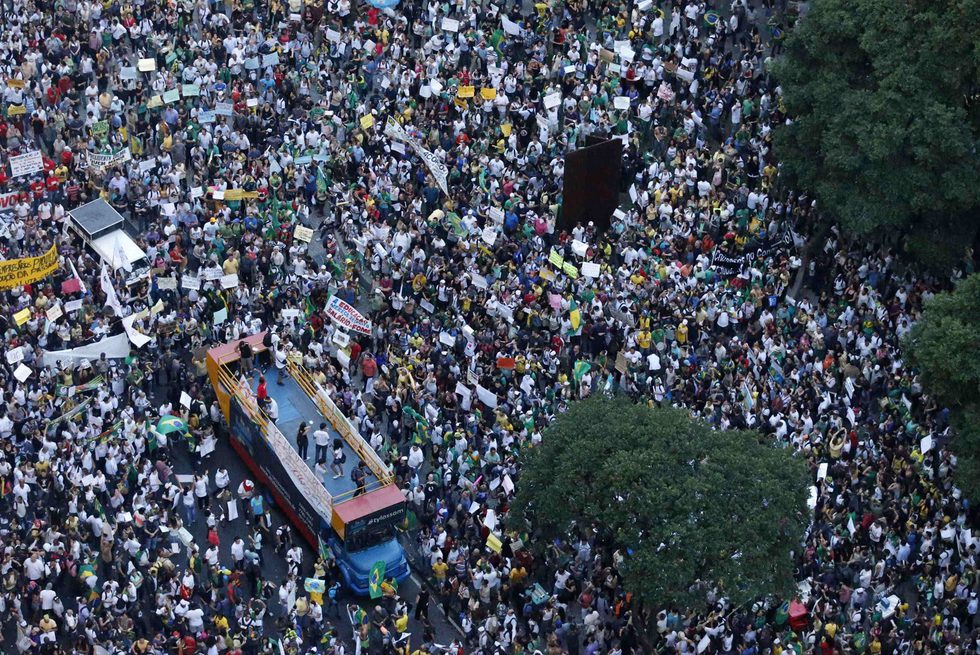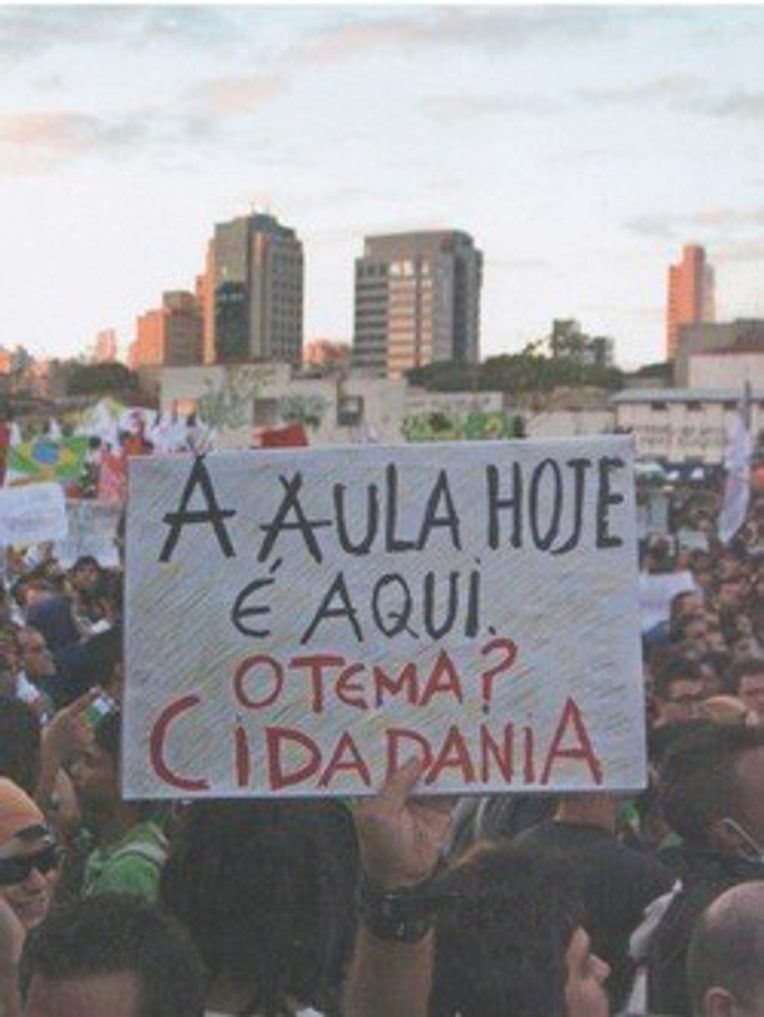“Come to the street”: Urban Protest, Brazil 2013
From the Series: Protesting Democracy in Brazil
From the Series: Protesting Democracy in Brazil

A remarkable aspect of the street demonstrations that overtook Brazilian cities in June was that protestors of all classes came together around many common issues. Commentators from Left to Right initially missed this production of a new body politic because they claimed that protestors were overwhelmingly “middle class.” As evidence, they pointed to the ubiquitous use of smartphones during the demonstrations to text, post, tweet, photograph, and video, assuming that only the middle classes own them. While this was probably true just a year ago, smartphone use is no longer a reliable indicator of class. Among residents I worked with in July in the decidedly non-middle-class favela of Maré in Rio de Janeiro, for example, around forty percent had smartphones or tablets.
My own sense is that residents of the lower-class peripheries had a strong presence in the demonstrations, though I cannot put numbers to class participation. This assessment is based on my work in Rio, on the research of Teresa Caldeira in São Paulo, and on three sets of images of class confrontation that appeared repeatedly in the protests and in posts about them. In the first set, a person (deemed middle class by formulaic associations of dress and physiognomy) carries a poster saying, “Brazil [or, the giant] has awoken” (figure 1). Juxtaposed to it is an image of another person who carries a sign that seems to refute this claim directly by asserting, “The periphery was never asleep” (figure 2). The second set presents the banner, “It’s not about 20 cents, it’s about rights.” Juxtaposed to it is the sign, “It’s the fucking 20 cents damn it” (É os 20 centavos pôrra), carried aloft by an enraged (often brown) body. It is difficult to make class, race, and space correlations on the fly in Brazil but not impossible. The third set of images compares exceptional police violence against middle-class demonstrators—the use of pepper spray and rubber bullets especially—and everyday police violence in the peripheries: “Rubber bullets in the center of the city are real bullets in the periphery.”


These images all point to the segregation between “center and periphery” (shifting and complex terms, to be sure) in urban Brazil that perdures in terms not only of life chances and basic services but also of knowledge about them. The lower-class protestors were telling the upper-class protestors as much in these dueling images.
So why should they share demands? Why should residents of the peripheries who suffer the absurdities of public transportation every day be joined in demanding “zero fare” by middle-class residents who use cars? Perhaps a plausible explanation lies in the everyday bodily experience of the city itself: given the low quality of urban life in Brazil (which looks especially bad in the light of gigantic expenditures on sport stadiums for the upcoming World Cup), different classes of people suffer the city’s injuries and indignities in their own ways, but that amounts to a discontent that is strongly shared. Commuting to work, periphery residents spend a shocking average of almost three hours a day packed like cattle in buses, vans, and trains that are always late because of snarled traffic. But residents who commute in cars are also stuck in traffic for hours. All are immobilized. With an average increase of seventy-eight percent in the urban fleet of cars between 2001 and 2011 in Brazilian metropolitan regions—the result of PT emphasis on automobile production and consumption over investment in public transportation—city arteries are now clogged. Especially for young people of all classes, mobility has not only become a style of life, an aspiration, but also a right. The Free Fare Movement (MPL) understands this urban dilemma and states it clearly in one of their principal slogans: “A city only exists for those who move around it.” Hence, “jump the turnstile” and “zero fare” are compelling for all protestors.
The middle classes generally turn a blind eye to police violence in the peripheries, but when the police gassed, sprayed, and beat their own in the first June demonstrations, they poured into the streets to protest. All are victims. Given the wealth of Brazil, public education and health care are pathetically endowed and the upper classes avoid them like the plague. But private education and health care now cost a fortune. All but the wealthiest are squeezed. All pay the price of the unrelenting corruption scandals that corrode the political system. Politicians of all parties thumb their noses at the public because they have effectively achieved impunity in a justice system that is obviously unjust. The PT spent a decade convincing Brazilians that consumption based on increased salaries and credit/debt has propelled Brazil into the league of middle-class nations and converted periphery residents into a “new middle class.” Few doubt the importance of these factors. However, Brazilians have their experiences of the city to show them that the actual quality of basic conditions does not correspond to the claims. In effect, the protests refuted this model of social development.
Hence, what brought people together is the generalized demand for a different kind of city, one free and just. Most important, people frame the failure of urban conditions in terms of rights. They share the sense that they have a right to better conditions of life that have not been realized; a right to the city they have made by living it that should be worthy of their efforts; a right that has been violated. Hence, protestors of all kinds talked about rights of all kinds. The sum of this rights-talk was, furthermore, something greater than a list of individual demands, as indicated by a poster that offered a more general assessment amid a sea of more specific demands: “The class today is here. The subject? Citizenship” (figure 3). It speaks to the discovery by a new generation of Brazilians of the city as the site of insurgence (the “here”) and of the life of its streets as the agenda of democratic citizenship (“the class”). In this assertion, the June protests indicate the development, after a decade of patience with PT national government, of new and different forms of the insurgent urban citizenship movements that transformed Brazil from the 1970s to the early 2000s.[1]
